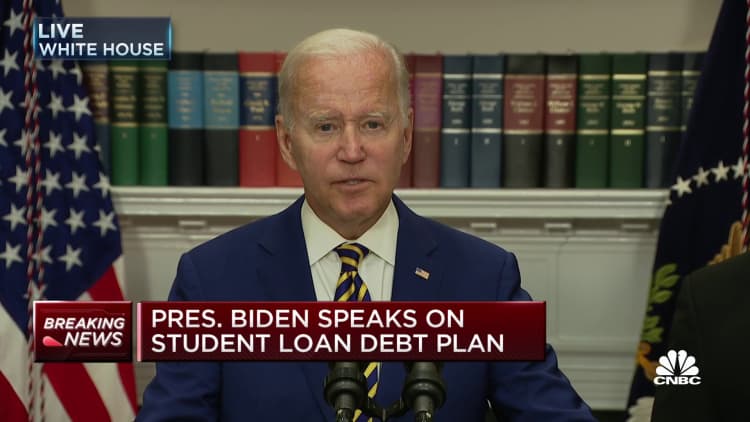How to calculate your state tax bill for student loan forgiveness

If you’re expecting relief from President Joe Biden’s plan to forgive up to $20,000 on student loans, you may be subject to state income tax depending on where you live.
As legislation evolves, it’s possible that seven states — Arkansas, California, Indiana, Minnesota, Mississippi, North Carolina and Wisconsin — may tax student loan forgiveness, according to an analysis by the Tax Foundation.
It depends on state compliance with federal laws, including the 2021 American Rescue Plan provision that makes student loan forgiveness federally tax-free through 2025.
More from Personal Finance:
These states may tax student loan forgiveness
When to Apply for Student Loan Forgiveness – 4 Important Dates to Know
Millions can get a refund for student loan payments made amid Covid
“Things could certainly change for the states that don’t comply,” said Annette Nellen, chartered accountant and spokesperson for the California Society of Certified Public Accountants. “There will be pressure”
This is how state income taxes work
While some states charge a flat rate for income taxes, others have a tiered system that increases your rate as income gets higher.
Generally, state taxes begin with your federal taxable income or adjusted gross income, according to certified financial planner Larry Harris, director of tax services at Parsec Financial in Asheville, North Carolina.
After that, state tax returns apply adjustments or subtractions before multiplying your income by the state’s tax rate, he said.
Of course, you must include the $10,000 or $20,000 in forgiven student debt as taxable income.
How to estimate your state tax liability
In a flat-tax state, you can multiply the loan amount forgiven by the state’s income tax rate for a quick estimate, Harris said. But it’s more difficult in states with tiered rates, he said.
For tiered rates, you can plug 2022 numbers into the calculation from your 2021 state tax return to estimate where your income might fall, Harris suggested.
“It may not be accurate, but it gives you an idea,” he said.

How much you may owe for student loan forgiveness
In principle, the tax rate only applies to the part of the income that falls within the respective range. And in some places, you may also need to consider local income taxes. Here’s a breakdown for each state.
Arkansas
With tiered income tax rates ranging from 2% to 4.9% for 2022, Arkansas state taxes depend on your income, according to a spokesman for the Arkansas Department of Treasury and Administration.
“The taxable amount for $10,000 of student loan relief in Arkansas could range from $200 to $490 depending on total taxable income,” they said.
California
san francisco
Noah Clayton | Getty Images
California residents also have tiered rates based on taxable income, with percentages ranging from 1% to 12.30%, although the higher tiers may exceed student loan forgiveness income limits.
“For example, if an individual has $40,000 in taxable income, their next income dollar will be taxed at 6%,” said Nellen of the California Society of Certified Public Accountants.
Indiana
Because Indiana has a flat tax rate of 3.23% for 2022, borrowers can multiply that percentage by either $10,000 or $20,000 for an estimated state tax liability of $323 or $646, an Indiana Treasury Department spokesman said.
However, Indiana residents may also have to pay county taxes depending on their jurisdiction. Here is a breakdown by state.
Minnesota
Minnesota income tax rates are also tiered, ranging from 5.35% to 9.85% for 2022. The state Treasury Department is working on a sample to make available to borrowers, according to a spokesman.
Mississippi
As of 2022, Mississippi has no state income tax on the first $5,000 of taxable income. However, according to the Mississippi Society of Certified Public Accountants, a flat rate of 5% applies to taxable income over $10,000.
By multiplying 5% by $10,000 or $20,000 in forgiveness, borrowers can estimate $500 or $1,000 in tax liability.
North Carolina
At a flat 2022 tax rate of 4.99%, $10,000 or $20,000 in debt forgiveness could trigger a $499 or $998 tax bill, respectively, Parsec Financial’s Harris said.
Wisconsin
Farm near Madison. Wisconin
Ron and Patty Thomas | E+ | Getty Images
In another state with tiered tax rates, potential tax liability in Wisconsin depends on income, with tax rates ranging from 3.54% to 5.3%.
For example, a single taxpayer with $50,000 in taxable income would have a top tax rate of 5.3%, a Wisconsin Treasury Department spokesman said.
“If they were forgiven $10,000 in student loans, their taxable income would increase by $10,000 and their tax rate would increase by $530 if they had no credit to set against their liabilities can,” they said.
Be “prepared” if your state is allowed to tax forgiveness
If you live in a state that can tax student loan forgiveness, you should “be prepared” and try to put the money aside, suggested CFP Ethan Miller, founder of Planning for Progress, which specializes in student loans in Washington, DC. Area.
Worst-case scenario: If you save the money and student loan forgiveness isn’t taxable in your state, you’ll have additional savings, he said. “Better safe than sorry,” he added.